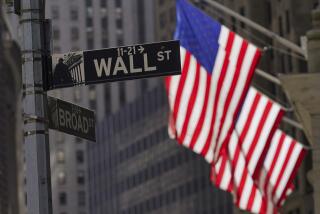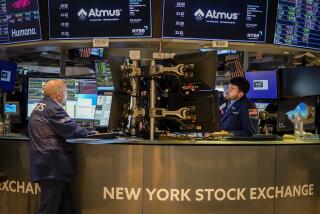Money Fund Yields Threaten to Vanish
The continuing slide in interest rates could cause bigger headaches soon for money market mutual funds, which already are paying record low yields.
The trend in rates also makes it more crucial than ever for money fund shareholders to pay attention to the management fees their funds charge, financial advisors say.
Yields on Treasury securities dropped across the board Wednesday as a weak April retail sales report raised the chances of another official Federal Reserve rate cut.
The 10-year T-note yield slid to 3.52% from Tuesday’s 3.61%, falling through the 45-year low of 3.56% reached in mid-March. Shorter-term yields also dropped, with the three-month T-bill ending at 1.03% on Wednesday, down from 1.08% on Tuesday.
It’s the short-term rates that have the $2.1-trillion money fund business on edge: The average seven-day yield on taxable money funds held at a record low 0.70% this week, according to fund tracker IMoneyNet.com. If the Fed cuts its benchmark rate in June by, say, a quarter of a percentage point or half a point, it would drive down by an equivalent amount the yields on the short-term corporate and government IOUs owned by money funds.
The danger is that, for some funds, another sharp drop in market rates would push fund yields to zero after management fees are deducted.
For many funds, the only answer would be to waive some portion of management fees -- which some are doing, and more may have to do soon, said Peter Crane, editor of IMoneyNet’s Money Fund Report in Westborough, Mass.
The alternative is that a fund might begin to have a “negative” yield, meaning its share value would fall below the $1 level. That’s a risk the industry doesn’t want to entertain, because investors have become conditioned to believe it’s impossible to lose principal in money funds.
“We will not allow negative yields in the fund,” said Steve Ward, head of the management group that runs the $52-billion Schwab Money Market Fund and other in-house funds at Charles Schwab Corp. in San Francisco.
Whether the fund actually waives expenses would depend on “competitive conditions” within the industry as well as how deeply the Fed cuts rates, if it does, Ward said.
Some firms already are shaving fees to maintain certain yield floors for higher-cost portfolios.
“We’re calibrating our reimbursement to make certain the yield stays at [or above] 0.05%,” said a spokeswoman for Pioneer Funds in Boston, referring to the broker-sold class B and C shares of the Pioneer Cash Reserves Fund.
Money fund managers are limited in the strategic moves they can make to try to keep yields up. Under federal rules, the weighted average maturity of the securities they own must be 90 days or less, for example.
Still, some are taking steps. Portfolio manager Denise Tabacco of American Century Prime Money Market Fund said she has partially hedged against the possibility of another Fed rate cut by investing a portion of assets in one-year CDs paying 1.20%, a return that would look better in the event the Fed eases credit again.
Her fund’s average maturity now is 70 days, she said, versus an industry average of 53 days.
Depressed money fund yields industrywide illustrate why shareholders should be vigilant about the management expenses their funds charge, experts say.
With the average gross money fund yield at 1.30%, the average annualized expense ratio of 0.60% is eating up nearly half that return, leaving a net yield of 0.70% for investors, according to IMoneyNet.
Not surprisingly, the lowest-yielding funds typically charge management fees that are well above the average.
The Munder Cash Investment Fund’s Class B and C shares, for example, yield 0.01% -- after deducting expenses of 1.31%, according to IMoneyNet.
Industrywide, Class A fund shares, which carry an upfront sales fee but lower ongoing expenses, and “no load” funds, which are bought directly by investors and carry no broker fees, generally are not in as dire straits as higher-expense classes, Crane said.
Of the 1,755 funds in IMoneyNet’s database, 128 are yielding 0.25% or less. About half of those are waiving some portion of fees to buffer yield, Crane estimated.
Some 385 funds with $178 billion, or 8.4% of industry assets, now yield 0.50% or less, so they and their investors could be stung particularly hard by a half-point Fed rate cut, Crane said.
Low money fund yields already have prompted some investors to ditch the funds. A net $110 billion has left the funds year-to-date, Crane said, although about three-quarters of that was pulled from funds used by institutional investors.
Advisors warn investors to be careful about trading the relative safety of money funds for bond funds and other assets that yield more but also carry the risk of principal loss if interest rates rise later in the year or in 2004.
*
(BEGIN TEXT OF INFOBOX)
Approaching zero
Here are some of the money market mutual funds with current yields near the zero mark. Funds with yields far below the average typically charge management expenses well above the average.
*--* Assets Average Fund (share class) (millions) 7-day yield Munder Cash Investment (B&C;) $43 0.01% Franklin Templeton Money (B) $56 0.04% Liberty U.S. Government Money (B) $130 0.05% Pioneer Cash Reserves (B&C;) $140 0.05% Van Kampen Reserve (B&C;) $421 0.05% Schwab Government Cash Reserves $622 0.06% Cash Management Trust of America (B&C;) $300 0.10% Oppenheimer Cash Reserves (A) $460 0.10% Smith Barney Exchange Reserves (B&C;) $250 0.10% Wells Fargo Overland Express Sweep $4,963 0.10% Evergreen Money Market (S) $6,508 0.11% Edward Jones Money Market (RS) $2,304 0.15% Wells Fargo Money Market (B) $1,829 0.15% Average taxable money market fund 0.70%
*--*
Source: IMoneyNet
More to Read
Inside the business of entertainment
The Wide Shot brings you news, analysis and insights on everything from streaming wars to production — and what it all means for the future.
You may occasionally receive promotional content from the Los Angeles Times.










